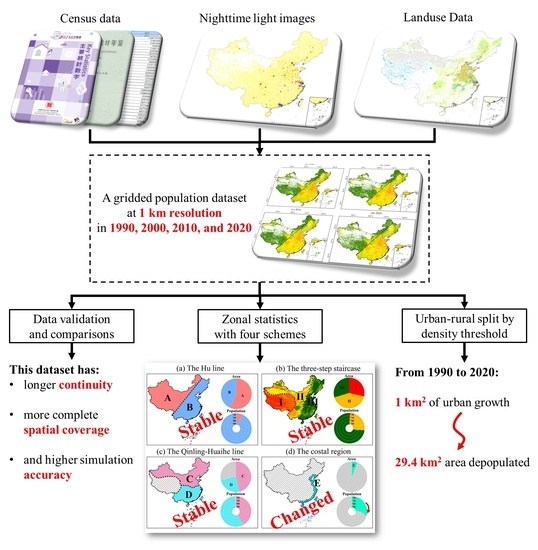Stability and Changes in the Spatial Distribution of China’s Population in the Past 30 Years Based on Census Data Spatialization
Abstract
:1. Introduction
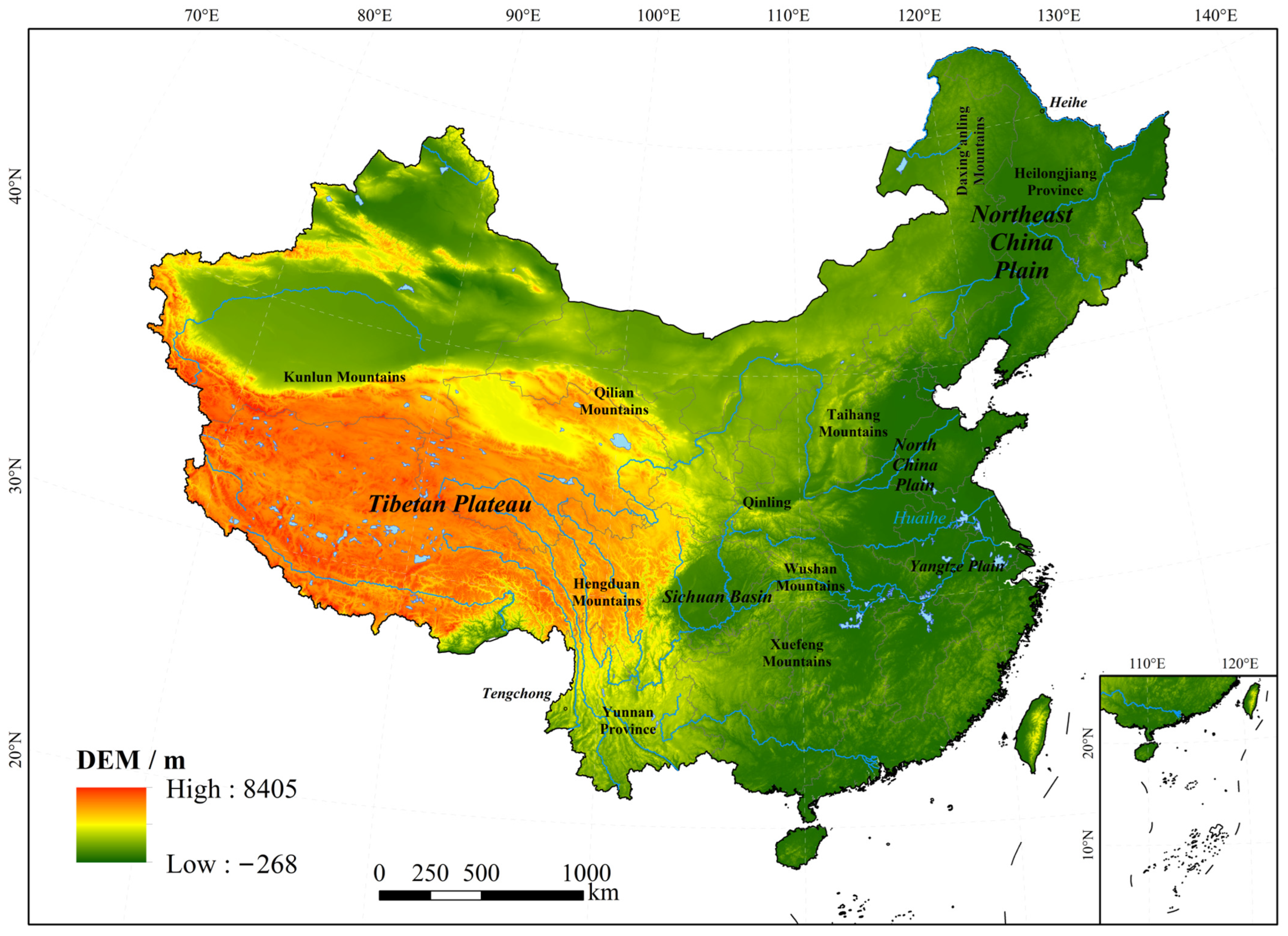
2. Materials and Methods
2.1. Data
2.1.1. Census Data
2.1.2. Nighttime Light (NTL) Data
2.1.3. Land Use Data
2.2. Spatialization of Population Data
2.2.1. Building the Models for Spatialization with an MLR Model
2.2.2. Reallocation of Population from the County-Level to 1 km Grid Cells
2.3. Time Period and Regional Divisions
2.3.1. The Hu Line
2.3.2. The Three-Step Staircase
2.3.3. The Qinling-Huaihe Line and the North/South of China
2.3.4. The Coastal Region
2.4. Distinction between Low-, Mid-, and High-Density (Urban) Areas
3. Results
3.1. Stability of the Spatial Distribution of China’s Population
3.1.1. Population Shares under the Split of the Hu Line
3.1.2. Population Shares on the Three-Step Staircase
3.1.3. Population Shares in the North and South of China
3.2. Changes in the Spatial Distribution of China’s Population
3.2.1. Change in Population Density
3.2.2. Changes in Population Share in the Coastal Region of China
4. Discussion and Policy Implications
4.1. Discussion
4.2. Policy Implications
- (1)
- The development of policies and plans should be based on an in-depth understanding of the relationship between people and land; otherwise, achieving their original design objectives will be difficult. Based on respect for the objective law of population distribution and growth, the government can set realistic targets for population development and resource allocation and thus formulate feasible regional and urban development plans.
- (2)
- Areas with rapid population growth, including urban and coastal areas, should receive more attention from the government and scholars. These areas should be the key areas for ecological construction and protection, and important projects and investments related to ecological protection should be more concentrated in these regions.
- (3)
- On the contrary, urbanization may improve the natural environment in vast rural areas by reducing their population pressure. As large numbers of people move into the cities, rural areas should not be the focus of large-scale ecological protection projects at the national level.
5. Conclusions
Author Contributions
Funding
Data Availability Statement
Conflicts of Interest
References
- Wang, Y. Analysis on the evolution of spatial relationship between population and economy in the Beijing-Tianjin-Hebei and Shandong region of China. Sustain. Cities Soc. 2022, 83, 103948. [Google Scholar] [CrossRef]
- Malah, A.; Bahi, H. Integrated multivariate data analysis for Urban Sustainability Assessment, a case study of Casablanca city. Sustain. Cities Soc. 2022, 86, 104100. [Google Scholar] [CrossRef]
- Communiqué of the Fourth National Population Census (No. 1). 1990. Available online: http://www.stats.gov.cn/sj/tjgb/rkpcgb/qgrkpcgb/202302/t20230206_1901990.html (accessed on 16 March 2023).
- Communiqué of the Seventh National Population Census (No. 7). 2021. Available online: http://www.stats.gov.cn/en/PressRelease/202105/t20210510_1817192.html (accessed on 16 March 2023).
- Cai, J.; Wang, G.; Yang, Z. Future trends and spatial patterns of migration in China. Popul. Res. 2007, 31, 9. [Google Scholar]
- Xu, D.; Deng, X.; Huang, K.; Liu, Y.; Yong, Z.; Liu, S. Relationships between labor migration and cropland abandonment in rural China from the perspective of village types. Land Use Policy 2019, 88, 104164. [Google Scholar] [CrossRef]
- Liang, Z.; Ma, Z. China’s floating population: New evidence from the 2000 census. Popul. Dev. Rev. 2004, 30, 467–488. [Google Scholar] [CrossRef]
- Zhu, Y.; Lin, L. Studies on the temporal processes of migration and their spatial effects in China: Progress and prospect. Sci. Geogr. Sin. 2016, 36, 820–828. [Google Scholar]
- Li, S.; Li, X. The mechanism of farmland marginalization in Chinese mountainous areas: Evidence from cost and return changes. J. Geogr. Sci. 2019, 29, 531–548. [Google Scholar] [CrossRef] [Green Version]
- Hu, H.Y. Distribution of Population in China, With Statistics and Maps. Acta Geogr. Sin. 1935, 2, 33–74. [Google Scholar]
- Hu, L.; Liu, Y.; Ren, Y.; Yu, L.; Qu, C. Spatial change of population density boundary in mainland China in recent 80 years. J. Remote Sens. 2015, 19, 928–934. [Google Scholar]
- Li, J.; Lu, D.; Xu, C.; Li, Y.; Chen, M. Spatial heterogeneity and its changes of population on the two sides of Hu Line. Acta Geogr. Sin. 2017, 72, 148–160. [Google Scholar]
- Yang, Q.; Li, L.; Wang, Y.; Wang, X.; Lu, Y. Spatial distribution pattern of population and characteristics of its evolution in China during 1935–2010. Geogr. Res. 2016, 35, 1547–1560. [Google Scholar]
- Lu, D.; Wang, Z.; Feng, Z.; Zeng, G.; Fang, C.; Dong, X.; Liu, S.; Jia, S.; Fang, Y.; Meng, G. Academic debates on Hu Huanyong population line. Geogr. Res 2016, 35, 805–824. [Google Scholar]
- Fang, C.; Liu, X. Temporal and spatial differences and imbalance of China’s urbanization development during 1950–2006. J. Geogr. Sci. 2009, 19, 719–732. [Google Scholar] [CrossRef]
- Deng, X.; Liang, L.; Wu, F.; Wang, Z.; He, S. A review of the balance of regional development in China from the perspective of development geography. J. Geogr. Sci. 2022, 32, 3–22. [Google Scholar] [CrossRef]
- Wang, Q.; Su, M. The effects of urbanization and industrialization on decoupling economic growth from carbon emission—A case study of China. Sustain. Cities Soc. 2019, 51, 101758. [Google Scholar] [CrossRef]
- Hou, H.-Y. Vegetation of China with reference to its geographical distribution. Ann. Mo. Bot. Gard. 1983, 70, 509–549. [Google Scholar] [CrossRef]
- Liang, L.; Zhao, S.-H.; Qin, Z.-H.; He, K.-X.; Chen, C.; Luo, Y.-X.; Zhou, X.-D. Drought Change Trend Using MODIS TVDI and Its Relationship with Climate Factors in China from 2001 to 2010. J. Integr. Agric. 2014, 13, 1501–1508. [Google Scholar] [CrossRef]
- Liu, Y.; Chen, C.; Li, Y. Differentiation regularity of urban-rural equalized development at prefecture-level city in China. J. Geogr. Sci. 2015, 25, 1075–1088. [Google Scholar] [CrossRef]
- Liu, T.; Peng, R.; Zhuo, Y.; Cao, G. China’s changing population distribution and influencing factors: Insights from the 2020 census data. Acta Geogr. Sin. 2022, 77, 381–394. [Google Scholar]
- Mao, Q.; Long, Y.; Wu, K. Spatio-Temporal Changes of Population Density and Urbanization Pattern in China (2000–2010). China City Plan. Rev. 2016, 25, 8–14. [Google Scholar]
- Guan, X.; Wei, H.; Lu, S.; Su, H. Mismatch distribution of population and industry in China: Pattern, problems and driving factors. Appl. Geogr. 2018, 97, 61–74. [Google Scholar] [CrossRef]
- Tan, M.; Li, X.; Li, S.; Xin, L.; Wang, X.; Li, Q.; Li, W.; Li, Y.; Xiang, W. Modeling population density based on nighttime light images and land use data in China. Appl. Geogr. 2018, 90, 239–247. [Google Scholar] [CrossRef]
- Li, S.; Sun, Z.; Tan, M.; Li, X. Effects of rural–urban migration on vegetation greenness in fragile areas: A case study of Inner Mongolia in China. J. Geogr. Sci. 2016, 26, 313–324. [Google Scholar] [CrossRef] [Green Version]
- Gaughan, A.E.; Stevens, F.R.; Huang, Z.; Nieves, J.J.; Sorichetta, A.; Lai, S.; Ye, X.; Linard, C.; Hornby, G.M.; Hay, S.I.; et al. Spatiotemporal patterns of population in mainland China, 1990 to 2010. Sci. Data 2016, 3, 160005. [Google Scholar] [CrossRef] [PubMed] [Green Version]
- Cao, G.; Chen, S.; Liu, T. Changing spatial patterns of internal migration to five major urban agglomerations in China. Acta Geogr. Sin. 2021, 76, 1334–1349. [Google Scholar]
- Wang, X. The Analysis of Evolution of Spatial Pattern of China’s Floating Population and Its Influencing Factors; East China Normal University: Shanghai, China, 2017. [Google Scholar]
- Wang, K.; Deng, Y. Can new urbanization break through the Hu Huanyong Line? Further discussion on the geographical connotations of the Hu Huanyong Line. Geogr. Res. 2016, 35, 11. [Google Scholar]
- Liu, J.; Yang, Q.; Liu, J.; Zhang, Y.; Jiang, X.; Yang, Y. Study on the spatial differentiation of the populations on both sides of the “Qinling-Huaihe Line” in China. Sustainability 2020, 12, 4545. [Google Scholar] [CrossRef]
- UN-DESA. World Population Prospects 2022: Ten Key Messages; UN-DESA: New York, NY, USA, 2022. [Google Scholar]
- Wang, C.; Wang, Z.-H. Projecting population growth as a dynamic measure of regional urban warming. Sustain. Cities Soc. 2017, 32, 357–365. [Google Scholar] [CrossRef] [Green Version]
- Li, J.; Sun, R.; Chen, L. Identifying sensitive population associated with summer extreme heat in Beijing. Sustain. Cities Soc. 2022, 83, 103925. [Google Scholar] [CrossRef]
- Verburg, P.H.; Veldkamp, T.; Bouma, J. Land use change under conditions of high population pressure: The case of Java. Glob. Environ. Change 1999, 9, 303–312. [Google Scholar] [CrossRef]
- Li, Y.; Kong, X.; Zhu, Z. Multiscale analysis of the correlation patterns between the urban population and construction land in China. Sustain. Cities Soc. 2020, 61, 102326. [Google Scholar] [CrossRef]
- Li, S.; Ma, Y. Urbanization, economic development and environmental change. Sustainability 2014, 6, 5143–5161. [Google Scholar] [CrossRef] [Green Version]
- Neil Adger, W. Social Vulnerability to Climate Change and Extremes in Coastal Vietnam. World Dev. 1999, 27, 249–269. [Google Scholar] [CrossRef]
- UN-Habitat. World Cities Report 2022: Envisaging the Future of Cities; UN-Habitat: Nairobi, Kenya, 2022. [Google Scholar]
- UN-DESA. 2018 Revision of World Urbanization Prospects; UN-DESA: New York, NY, USA, 2018. [Google Scholar]
- Report of the Inter-agency and Expert Group on Sustainable Development Goal Indicators (Revised). In Annex IV: Final List of Proposed Sustainable Development Goal Indicators; United Nations Economic and Social Counsil: New York, NY, USA, 2017; Available online: https://sustainabledevelopment.un.org/content/documents/11803Official-List-of-Proposed-SDG-Indicators.pdf (accessed on 26 January 2023).
- Schiavina, M.; Freire, S.; MacManus, K. GHS-POP R2022A—GHS Population Grid Multitemporal (1975–2030). European Commission, Joint Research Centre. 2022. Available online: https://doi.org/10.2905/D6D86A90-4351-4508-99C1-CB074B022C4A (accessed on 29 January 2023).
- Center for International Earth Science Information Network—CIESIN—Columbia University. Gridded Population of the World, Version 4 (GPWv4): Population Density Adjusted to Match 2015 Revision UN WPP Country Totals, Revision 11. 2018. Available online: https://doi.org/10.7927/H4F47M65 (accessed on 29 January 2023).
- Teng, F.; Wang, Y.; Wang, M.; Wang, L. Monitoring and Analysis of Population Distribution in China from 2000 to 2020 Based on Remote Sensing Data. Remote Sens. 2022, 14, 6019. [Google Scholar] [CrossRef]
- Wardrop, N.; Jochem, W.; Bird, T.; Chamberlain, H.; Clarke, D.; Kerr, D.; Bengtsson, L.; Juran, S.; Seaman, V.; Tatem, A. Spatially disaggregated population estimates in the absence of national population and housing census data. Proc. Natl. Acad. Sci. USA 2018, 115, 3529–3537. [Google Scholar] [CrossRef] [Green Version]
- Leyk, S.; Gaughan, A.E.; Adamo, S.B.; de Sherbinin, A.; Balk, D.; Freire, S.; Rose, A.; Stevens, F.R.; Blankespoor, B.; Frye, C. The spatial allocation of population: A review of large-scale gridded population data products and their fitness for use. Earth Syst. Sci. Data 2019, 11, 1385–1409. [Google Scholar] [CrossRef] [Green Version]
- Liu, X.; Xin, L. Assessment of the Efficiency of Cultivated Land Occupied by Urban and Rural Construction Land in China from 1990 to 2020. Land 2022, 11, 941. [Google Scholar] [CrossRef]
- Liu, Z. Dynamic Population Exposure and Anomaly Response Pattern Mining of Typhoon Events Using Big Data; Chinese Academy of Sciences: Beijing, China, 2019. [Google Scholar]
- Holt, J.B.; Lo, C.; Hodler, T.W. Dasymetric estimation of population density and areal interpolation of census data. Cartogr. Geogr. Inf. Sci. 2004, 31, 103–121. [Google Scholar] [CrossRef]
- Robinson, C.; Hohman, F.; Dilkina, B. A deep learning approach for population estimation from satellite imagery. In Proceedings of the 1st ACM SIGSPATIAL Workshop on Geospatial Humanities, Redondo Beach, CA, USA, 7–10 November 2017; pp. 47–54. [Google Scholar]
- Fang, Y.; Jawitz, J.W. High-resolution reconstruction of the United States human population distribution, 1790 to 2010. Sci. Data 2018, 5, 180067. [Google Scholar] [CrossRef] [Green Version]
- Communiqué of the Seventh National Population Census (No. 3). 2021. Available online: http://www.stats.gov.cn/en/PressRelease/202105/t20210510_1817188.html (accessed on 16 March 2023).
- Xu, X.; Liu, J.; Zhang, S.; Li, R.; Yan, C.; Wu, S. China’s Multi-Period Land Use Land Cover Remote Sensing Monitoring Data Set (CNLUCC); Resource and Environment Data Cloud Platform: Beijing, China, 2018. [Google Scholar]
- Sun, W.; Zhang, X.; Wang, N.; Cen, Y. Estimating Population Density Using DMSP-OLS Night-Time Imagery and Land Cover Data. IEEE J. Sel. Top. Appl. Earth Obs. Remote Sens. 2017, 10, 2674–2684. [Google Scholar] [CrossRef]
- Wang, L.; Wang, S.; Zhou, Y.; Liu, W.; Hou, Y.; Zhu, J.; Wang, F. Mapping population density in China between 1990 and 2010 using remote sensing. Remote Sens. Environ. 2018, 210, 269–281. [Google Scholar] [CrossRef]
- Qiang, Z.; Lanying, H.; Jingjing, L.; Qingyan, C. North–south differences in Chinese agricultural losses due to climate-change-influenced droughts. Theor. Appl. Climatol. 2018, 131, 719–732. [Google Scholar] [CrossRef]
- Xu, L.; Qu, J.; Han, J.; Zeng, J.; Li, H. Distribution and evolutionary in household energy-related CO2 emissions (HCEs) based on Chinese north–south demarcation. Energy Rep. 2021, 7, 6973–6982. [Google Scholar] [CrossRef]
- Deng, Y.; Gao, Q.; Yang, T.; Wu, B.; Liu, Y.; Liu, R. Indoor solid fuel use and incident arthritis among middle-aged and older adults in rural China: A nationwide population-based cohort study. Sci. Total Environ. 2021, 772, 145395. [Google Scholar] [CrossRef] [PubMed]
- Fang, J.-Y.; Shi, P.-J. A review of coastal flood risk research under global climate change. Prog. Geogr. 2019, 38, 625–636. [Google Scholar]
- Dasgupta, S.; Wheeler, D.; Bandyopadhyay, S.; Ghosh, S.; Roy, U. Coastal dilemma: Climate change, public assistance and population displacement. World Dev. 2022, 150, 105707. [Google Scholar] [CrossRef]
- The Intergovernmental Oceanographic Commission of UNESCO Enhancing Coastal Resilience during the UN Ocean Decade. Available online: https://www.oceandecade.org/news/enhancing-coastal-resilience-during-the-un-ocean-decade/ (accessed on 26 August 2022).
- Hu, P.; Zhang, Q.; Shi, P.; Chen, B.; Fang, J. Flood-induced mortality across the globe: Spatiotemporal pattern and influencing factors. Sci. Total Environ. 2018, 643, 171–182. [Google Scholar] [CrossRef]
- Shi, M. A Study of Population Distribution and Population Vulnerability to Natural Hazards in Low Elevation Coastal Zone of China. Master’s Thesis, Shanghai Normal University, Shanghai, China, 2012. [Google Scholar]
- Regulations on the Statistical Division of Urban and Rural Areas (for Trial Implementation). Available online: http://www.stats.gov.cn/tjsj/pcsj/rkpc/5rp/html/append7.htm (accessed on 17 September 2022).
- Chen, Y.; Zhang, D. Evaluation and driving factors of city sustainability in Northeast China: An analysis based on interaction among multiple indicators. Sustain. Cities Soc. 2021, 67, 102721. [Google Scholar] [CrossRef]
- Ren, Z. China’s Great Migration Report. 2021. Available online: https://www.yicai.com/news/101077169.html (accessed on 2 October 2021).
- Li, H. Data of 20 Years Prove That “Peacocks Flying Southeast” Uninterrupted. Available online: http://ep.ycwb.com/epaper/ycwb/html/2020-03/17/content_130_245058.htm (accessed on 2 October 2022).
- Kaifeng. Peacocks Flying Southeast! Who Is the Next City of 10 Million People? Available online: https://www.21jingji.com/article/20210609/herald/47f4e2d5fc21f9848b83d1a83632edf9.html (accessed on 2 October 2022).
- Abernethy, V.D. Carrying capacity: The tradition and policy implications of limits. Ethics Sci. Environ. Politics 2001, 2001, 9–18. [Google Scholar] [CrossRef]
- Lane, M. The carrying capacity imperative: Assessing regional carrying capacity methodologies for sustainable land-use planning. Land Use Policy 2010, 27, 1038–1045. [Google Scholar] [CrossRef] [Green Version]
- Wei, Y.; Huang, C.; Lam, P.T.I.; Yuan, Z. Sustainable urban development: A review on urban carrying capacity assessment. Habitat Int. 2015, 46, 64–71. [Google Scholar] [CrossRef]
- Yan, Z.; Hui, L.; Wenbin, J.; Liuxue, L.; Yuemei, L.; Bohan, L.; Lili, W. Third birth intention of the childbearing-age population in mainland China and sociodemographic differences: A cross-sectional survey. BMC Public Health 2021, 21, 2280. [Google Scholar] [CrossRef] [PubMed]
- Zhang, J.; Ding, S.; Hu, X. Analysis of spatial and temporal impact differences of birth rate in mainland China. Sci. Rep. 2022, 12, 17396. [Google Scholar] [CrossRef]
- Li, W.; Tan, M. Spatial redistribution of populations in mountainous areas and its impact on vegetation change in southwest China: A riverside case study. Acta Ecol. Sin. 2018, 38, 8879–8887. [Google Scholar]
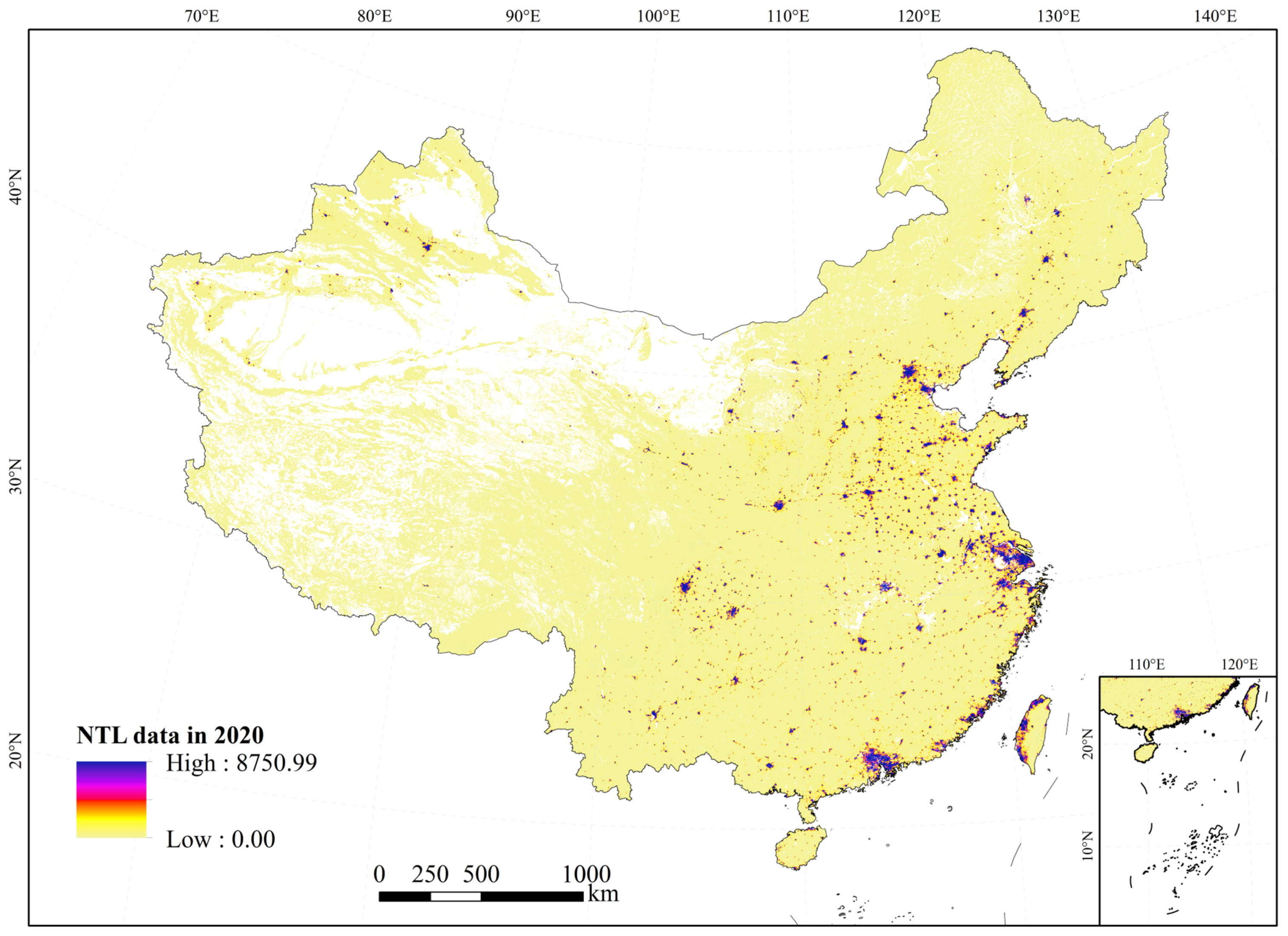




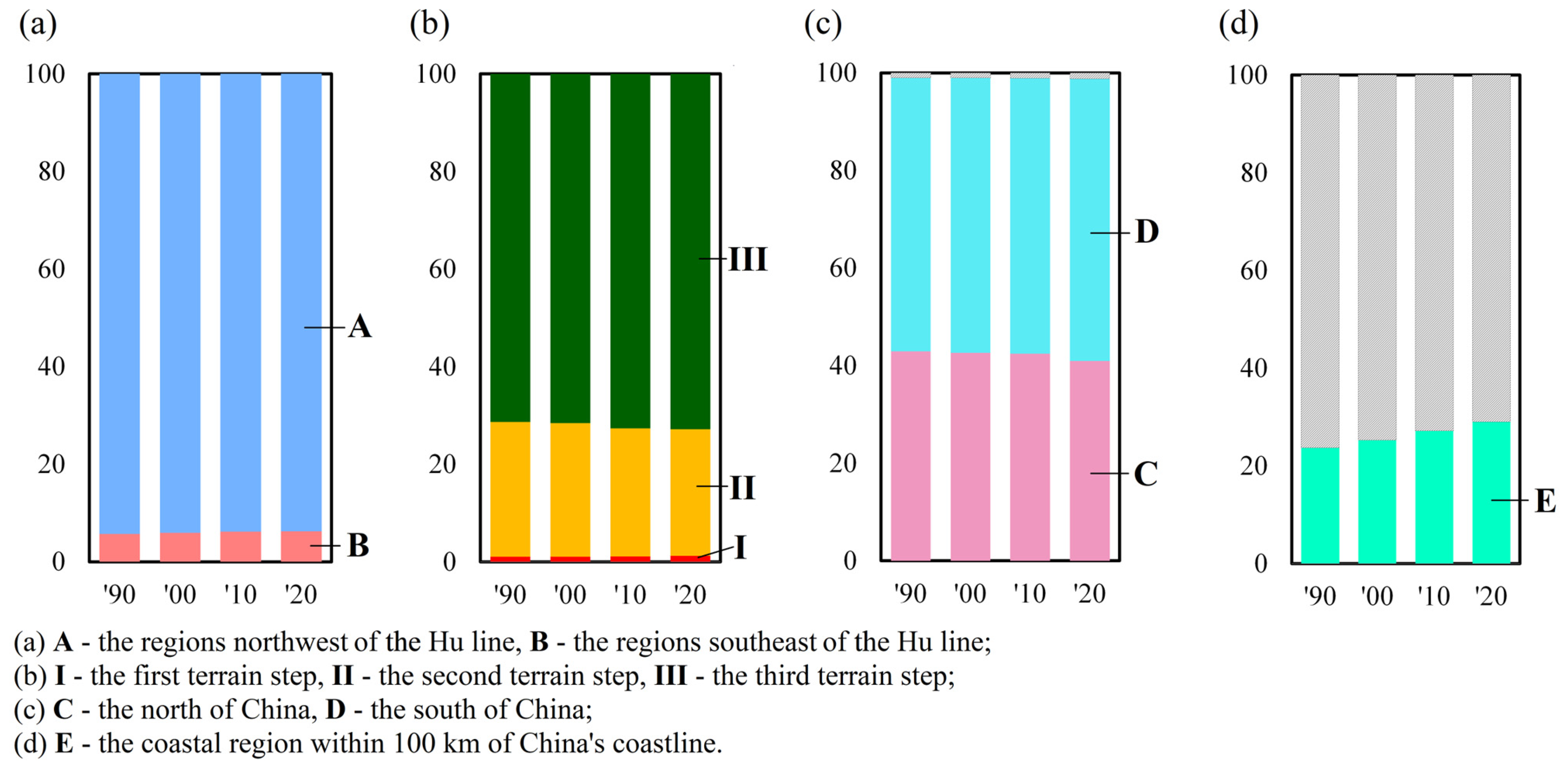
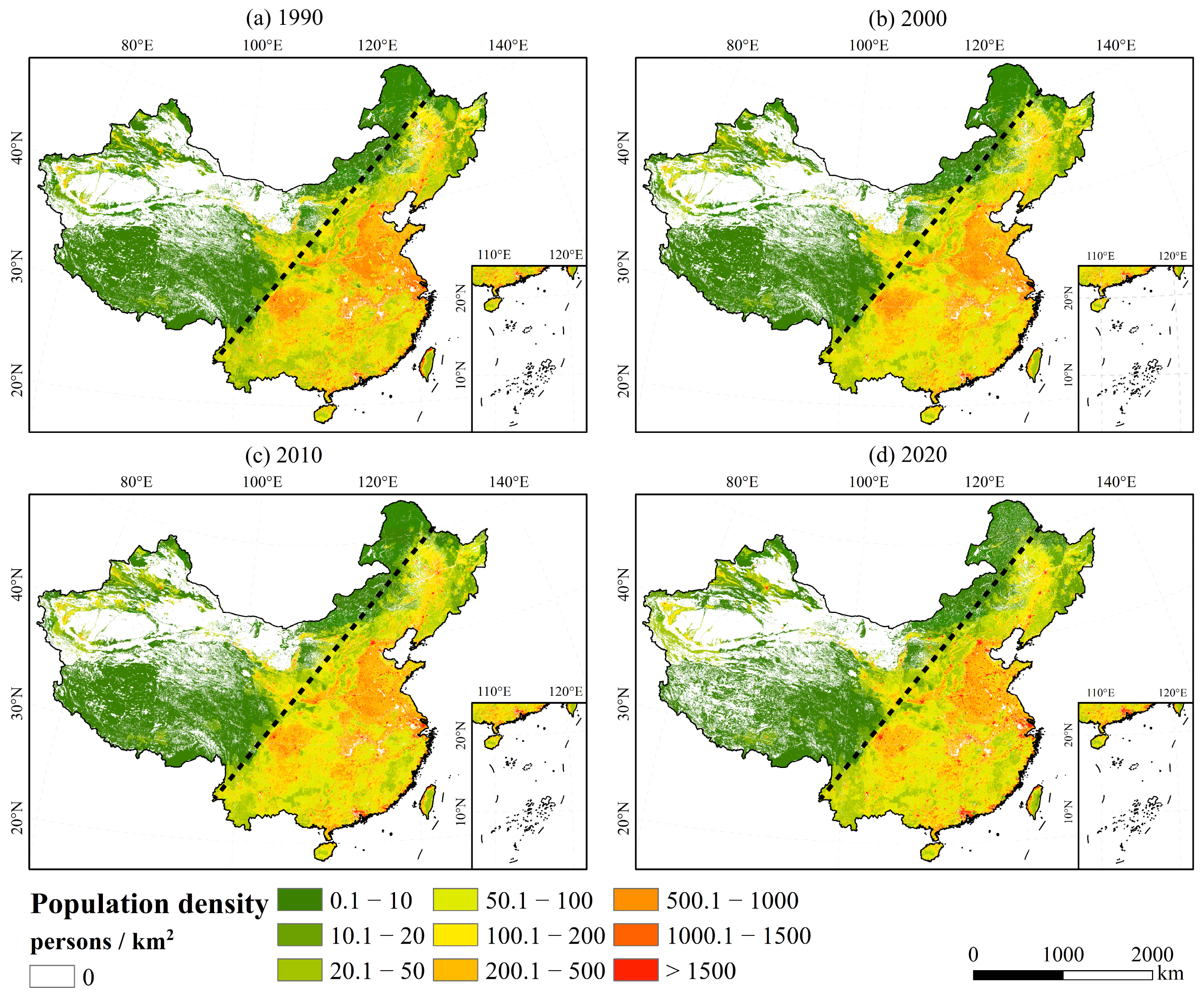

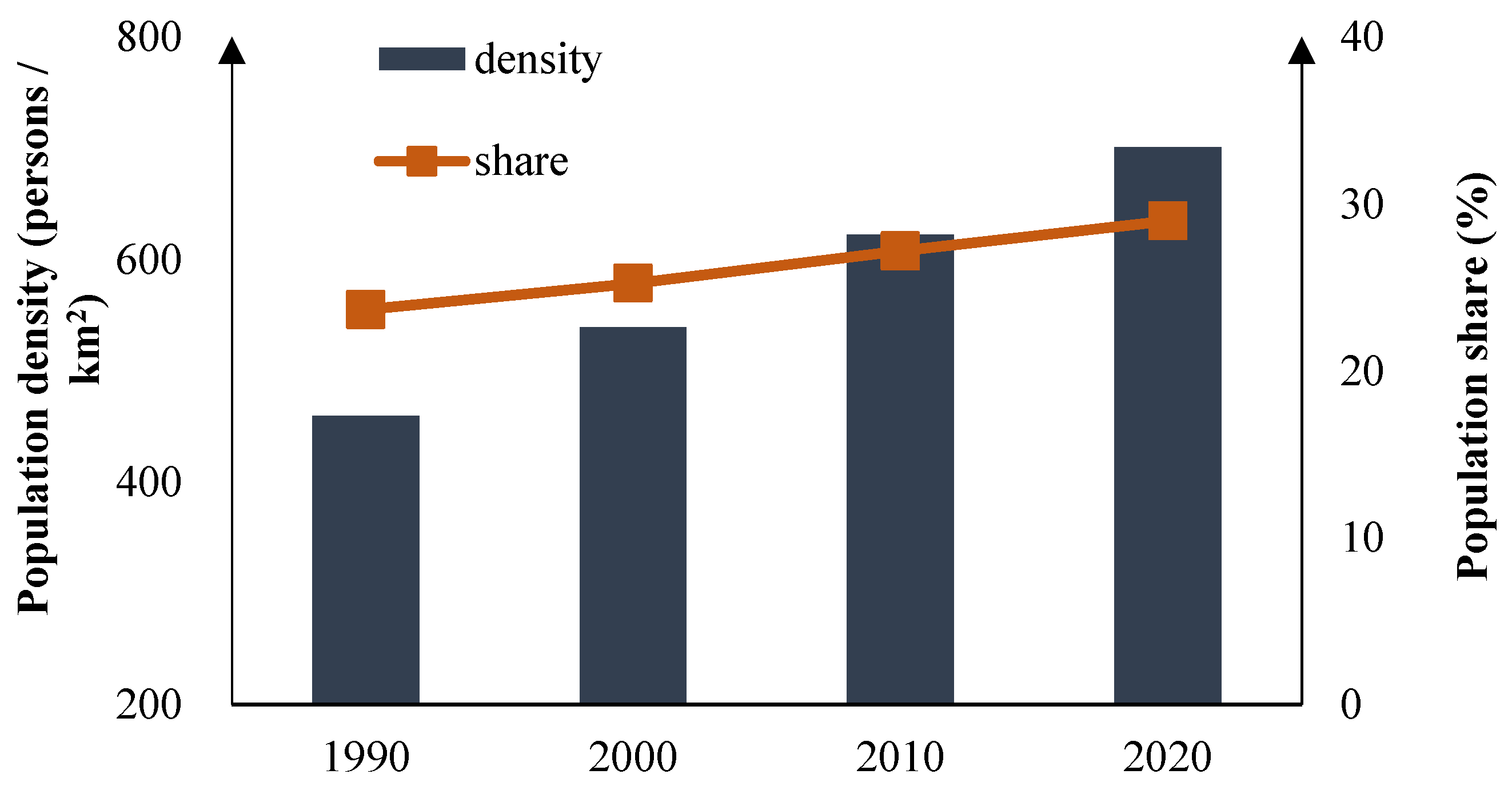
| Regions | Years | Data Scale | Data Source |
|---|---|---|---|
| Mainland China | 1990, 2000, 2010, 2020 | Prefectural-level for Xinjiang in 2020, county-level for other regions and years | The 4th, 5th, 6th, and 7th National Population Census of China |
| Hong Kong | 1991, 2001, 2011, 2021 | Region-wide | Population census in Hong Kong in 1991, 2001, 2011, and 2021 |
| Macau | 1991, 2001, 2011, 2021 | Region-wide | The 13th, 14th, 15th, and 16th population census in Macau |
| Taiwan Area | 1990, 2000, 2010, 2020 | County-level for 2020, region-wide for other years | Taiwan Population and Housing Census in 1990, 2000, 2010, and 2020 |
| Province-Level Divisions | Cities (Number of Counties in Parentheses) | |
|---|---|---|
| 1 | Beijing Municipality | Beijing (16) |
| 2 | Shanxi Province | Taiyuan (10), Jincheng (6), Shuozhou (6) |
| 3 | Jilin Province | Liaoyuan (4) |
| 4 | Zhejiang Province | Ningbo (10) |
| 5 | Anhui Province | Huainan (7), Suzhou (5) |
| 6 | Hunan Province | Xiangtan (5) |
| 7 | Guangdong Province | Shaoguan (10), Zhaoqing (8), Yangjiang (4), Dongguan (1), Zhongshan (1) |
| 8 | Shaanxi Province | Yulin (12) |
| 9 | Ningxia Hui Autonomous Region | Yinchuan (6), Shizuishan (3), Wuzhong (5), Guyuan (5), Zhongwei (3) |
| County-level divisions | 127 in all. | |
| Township-level divisions | 1838 township-level divisions in 2010, and 1796 township-level divisions in 2020. | |
| 1990 | 15.298 | 104.636 | 18.667 | 8.671 | 0.774 | 6.711 | 0.6384 |
| 2000 | 11.791 | 145.668 | 53.877 | 56.129 | 0.046 | 8.473 | 0.8183 |
| 2010 | 11.293 | 133.493 | 37.455 | 66.618 | 0.094 | 8.436 | 0.7466 |
| 2020 | 10.438 | 82.191 | 23.986 | 50.950 | 1.332 | 7.676 | 0.9098 |
| Population Density Regions | Population Density (Persons/km2) * | Area (104 km2) | Population (106 Persons) | ||||||
|---|---|---|---|---|---|---|---|---|---|
| 1990 | 2000 | 2010 | 2020 | 1990 | 2000 | 2010 | 2020 | ||
| Low-density | 0–20 | 314.72 | 297.15 | 291.57 | 273.30 | 16.09 | 15.61 | 16.00 | 16.90 |
| 20–50 | 88.71 | 81.74 | 87.50 | 101.54 | 30.12 | 28.50 | 30.53 | 35.64 | |
| 50–100 | 93.01 | 114.17 | 117.20 | 117.90 | 66.51 | 82.71 | 85.00 | 84.41 | |
| 100–200 | 79.12 | 92.83 | 93.56 | 84.85 | 112.47 | 130.92 | 132.25 | 119.28 | |
| Mid-density | 200–500 | 88.59 | 91.71 | 94.86 | 87.14 | 295.61 | 294.92 | 304.60 | 273.00 |
| 500–1500 | 48.98 | 34.81 | 26.01 | 18.59 | 334.99 | 250.31 | 184.42 | 141.61 | |
| High-density | 1500–3000 | 2.30 | 2.51 | 2.74 | 4.22 | 47.19 | 51.18 | 57.41 | 89.45 |
| >3000 | 2.98 | 3.98 | 5.51 | 8.19 | 253.76 | 417.64 | 553.13 | 682.61 | |
Disclaimer/Publisher’s Note: The statements, opinions and data contained in all publications are solely those of the individual author(s) and contributor(s) and not of MDPI and/or the editor(s). MDPI and/or the editor(s) disclaim responsibility for any injury to people or property resulting from any ideas, methods, instructions or products referred to in the content. |
© 2023 by the authors. Licensee MDPI, Basel, Switzerland. This article is an open access article distributed under the terms and conditions of the Creative Commons Attribution (CC BY) license (https://creativecommons.org/licenses/by/4.0/).
Share and Cite
Xu, X.; Tan, M.; Liu, X.; Wang, X.; Xin, L. Stability and Changes in the Spatial Distribution of China’s Population in the Past 30 Years Based on Census Data Spatialization. Remote Sens. 2023, 15, 1674. https://doi.org/10.3390/rs15061674
Xu X, Tan M, Liu X, Wang X, Xin L. Stability and Changes in the Spatial Distribution of China’s Population in the Past 30 Years Based on Census Data Spatialization. Remote Sensing. 2023; 15(6):1674. https://doi.org/10.3390/rs15061674
Chicago/Turabian StyleXu, Xiaofan, Minghong Tan, Xiaoyu Liu, Xue Wang, and Liangjie Xin. 2023. "Stability and Changes in the Spatial Distribution of China’s Population in the Past 30 Years Based on Census Data Spatialization" Remote Sensing 15, no. 6: 1674. https://doi.org/10.3390/rs15061674






